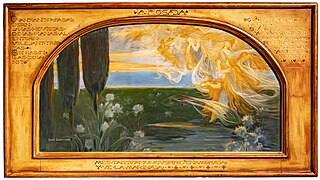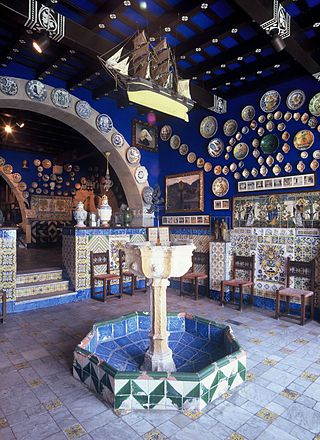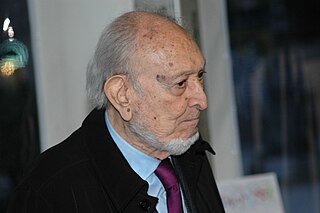
Modernisme, also known as Catalan modernism and Catalan art nouveau, is the historiographic denomination given to an art and literature movement associated with the search of a new entitlement of Catalan culture, one of the most predominant cultures within Spain. Nowadays, it is considered a movement based on the cultural revindication of a Catalan identity. Its main form of expression was Modernista architecture, but it also encompassed many other arts, such as painting and sculpture, and especially the design and the decorative arts, which were particularly important, especially in their role as support to architecture. Modernisme was also a literary movement.

Lluís Domènech i Montaner was a Catalan architect who was very much involved in and influential for the Catalan Modernisme català, the Art Nouveau/Jugendstil movement. He was also a Catalan politician.

Santiago Rusiñol i Prats was a Catalan painter, poet, journalist, collector and playwright. He was one of the leaders of the Catalan modernisme movement. He created more than a thousand paintings and wrote numerous works in Catalan and Spanish.

Ramon Casas i Carbó was a Catalan artist. Living through a turbulent time in the history of his native Barcelona, he was known as a portraitist, sketching and painting the intellectual, economic, and political elite of Barcelona, Paris, Madrid, and beyond. He was also known for his paintings of crowd scenes ranging from the audience at a bullfight to the assembly for an execution to rioters in the Barcelona streets. Also a graphic designer, his posters and postcards helped to define the Catalan art movement known as modernisme.

Adrià Gual i Queralt was a Catalan playwright and theatre businessman, founder of the Escola Catalana d'Art Dramàtic and a pioneer of cinema in Barcelona.
The siege of Hostalric was the first major action of the War Against John II. It took place on 23 May 1462.

Cau Ferrat, located in Sitges, was the home and study of artist and writer Santiago Rusiñol, one of the most important figures of the Modernisme movement in Catalonia. It is one of the three museums in Sitges located on the shores of Sant Sebastià beach.

The Maricel Museum is a museum located in the centre of Sitges; reopened after a major refurbishment in 2015.

Lluïsa Vidal i Puig was a painter. Raised in a well-off family closely related to Catalan modernist circles, she is known as the only professional woman painter of Catalan modernism, and one of the few women of that period who went abroad to receive art lessons.

Josep Maria Castellet Díaz de Cossío, also known as José María Castellet, was a Spanish Catalan writer, poet, literacy critic, publisher and editor.

Arcadi Mas i Fondevila, or Fontdevila, was a Catalan painter and graphic artist.

Valentí Serra i Fornell, is a Spanish Capuchin and priest, whose religious name is Valentí Serra de Manresa.

Rossend Nobas i Ballbé was a Catalan sculptor and goldsmith in the 19th century. Working mainly in Barcelona, Nobas's work is to be found around the city in both museums and public areas.
Caterina d'Ortafà, was a Catalan noblewoman. She is known for her defense of Canet-en-Roussillon during the French invasion of Roussilon following the Catalan Civil War in 1474.
Oscar Tusquets Blanca, is a Spanish architect.

Agapit Vallmitjana i Barbany was a Spanish sculptor, in the Realist style. His brother Venanci was also a sculptor, with whom he usually collaborated.

Tomàs Moragas i Torras was a Spanish painter; known for his Orientalist and genre scenes.

Raimon Casellas i Dou was a Catalan journalist, art critic, modernisme narrator and collector. Author of Els sots feréstecs (1901), a work considered the first modernist novel in Catalan language and a forerunner of the current known as rural naturalism. Els sots feréstecs was translated to English by Alan Yates and published by Dedalus.

















